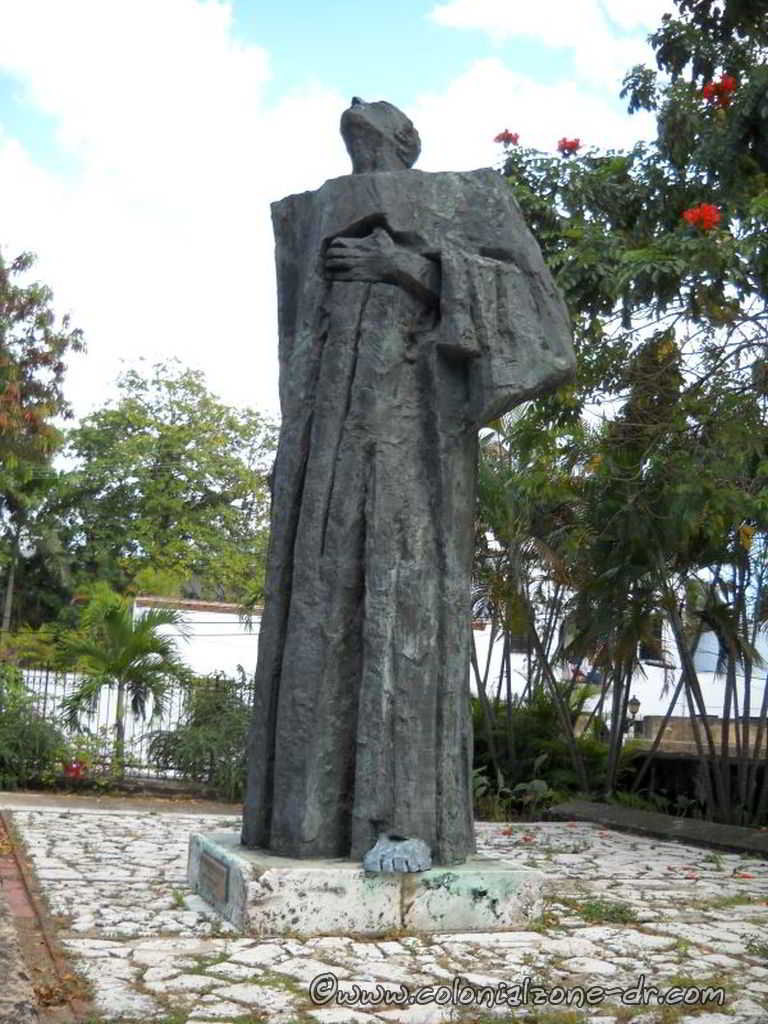Wecome to the garden of recontextualized statuary
 By Kenneth C. Zirkel - Own work, Public Domain, Link |  |
|
This pamphlet offers a self-guided tour of the grounds. Welcome to our garden! Facing the entrance, you'll see a statue of Christopher Columbus, rescued from a park in Providence, Rhode Island. His many crimes against humanity are often excused by saying we should not judge fifteenth-century people by twenty-first century standards. This is why he is here standing next to a statue of Bartolome de las Casas, a contemporary of Columbus who was a member of the very first cohort of settlers in Hispaniola. De las Casas, who became a priest, wrote that he was appalled by the treatment of the indigenous peoples and spent most of his life as an anti-slavery crusader. Despite his early endorsement of substituting African slaves for Indians (a position he eventually renounced) you see de las Casas here at the start of our "Abolitionist Lane," to your left, including William Lloyd Garrison, Harriet Beecher Stowe, the Langston Brothers, and Frederick Douglass. You'll notice quite a few 17th and 18th century entries, before the Garrison crowd, with William Wilberforce of England and Maximilien Robespierre (yes, that Robespierre) in the parade. Incidentally, that's Moses Brown of Providence in there, with a number of other American Quakers. Across the lane from the procession is the Thomas Jefferson/Sally Hemings couple. Jefferson was, of course, hardly an abolitionist, but words he wrote are credited by many with sparking the Haitian Revolution of 1791, the slave rebellion which reshaped the American South over fears of copycat revolts. That's Haitian revolutionary general Toussaint Louverture behind him. Jefferson is shown here beside Hemings, his slave concubine, with whom he had six children, the same as with his wife. Just beyond the lane, to the right, you'll find our Civil War collection. This extensive collection of statues of Confederate officers, such as Robert E. Lee, Nathan Bedford Forrest and J.E.B. Stuart, were donated by grateful cities across the South and Midwestern states. You see them there surrounded by Generals George Thomas and Winfield Scott of Virginia, Generals Robert Anderson and Cassius Clay of Kentucky, Alabama's Andrew Hamilton, Tennessee's Commander David Farragut (of "Damn the torpedoes" fame), all southern military officers who chose to honor their oath of loyalty to the United States over the treasonous course taken by too many of their peers. You'll see crowd favorite Jefferson "Jeff" Davis just past this group. He's shadowed here by Nat Turner, the leader of the famous 1831 Virginia slave rebellion. Fear of another slave rebellion during the Civil War, as well as the natural inclination of the planter class to let others do the fighting, prevented the Confederacy from recruiting nearly enough soldiers for its army, and kept the Davis government close to collapse from its inception. Facing and above, you'll see a figure meant to represent the Black soldiers who fought for the Union. The empty pedestal next to him represents the number of Black soldiers who fought to defend the "peculiar institution" of slavery. Moving on to your right you'll see a number of military men made famous by their Western exploits. That's George Custer there, with the hair, and Phil Sheridan to his right. Facing them -- on the taller plinth of course -- are Chief Joseph of the Nez Perce, Sitting Bull of the Lakota, and other leaders of the indigenous resistance in the 19th century America West. The plaques beneath them are too small to list all the betrayals by the US Government they faced in their lives, but you can find a helpful summary list on our web site. Finally, another right turn brings you to the "Lane of Industry." That's Andrew Carnegie, Andrew Mellon, Henry Frick, and John D. Rockefeller there, faced by Eugene Debs, co-founder of the Wobblies, Samuel Gompers, co-founder of the AFL, and the a tableau representing the nine victims of Carnegie's 1892 Homestead massacre, the six victims of Frick's 1891 Morewood massacre, and the 21 victims of Rockefeller's 1913 Ludlow Massacre, and the 2,200 people who died in the 1889 Johnstown Flood caused by the failure of a dam at Frick and Mellon's private hunting club. A little further and you'll see a majestic scene of Henry Ford behind John L. Lewis, founder of the CIO, and a depiction of the 5 dead and 60 injured by machine-gun fire in Dearborn's 1932 Ford Massacre. This is the end of the mini-tour. Another right turn will bring you to the exit, or a left will find stories of the 20th century, including Franklin Roosevelt with American citizen Fred Korematsu, imprisoned during WWII because of his Japanese ancestry, the baseball commissioner Kenesaw Mountain Landis with the Black stars Josh Gibson and Satchel Paige who couldn't play in his league, lovable Eisenhower's problem with loyalty oaths, John F. Kennedy with John R. Lewis, and many more. Remember, figures from history should not be judged by modern standards, but it's always worth asking who wrote the history. Thank you for visiting our garden. If you enjoyed your visit, please leave a tip for our staff on the Pope Pius XII collection plate you'll see at the exit. And please tell your friends! by Tom Sgouros, 10/2020 | |